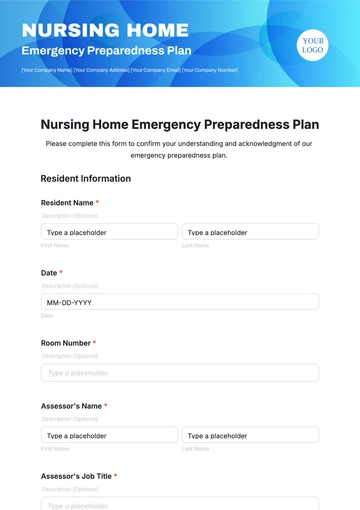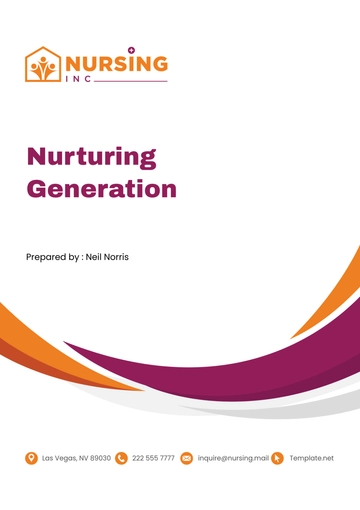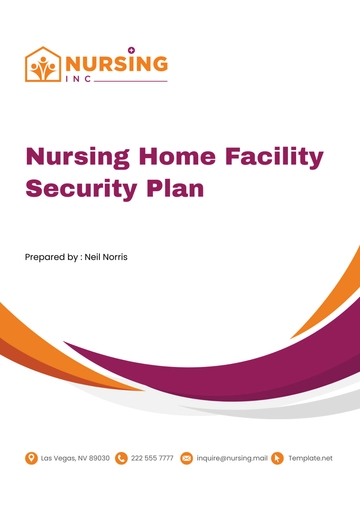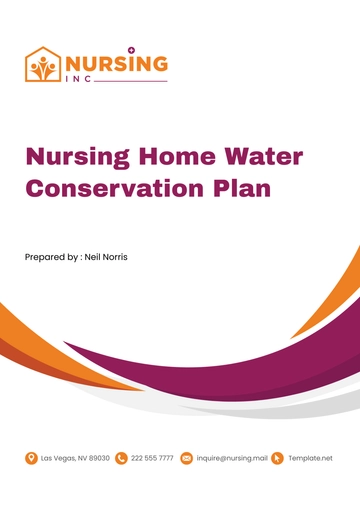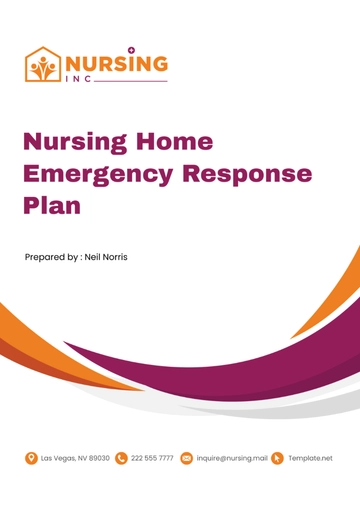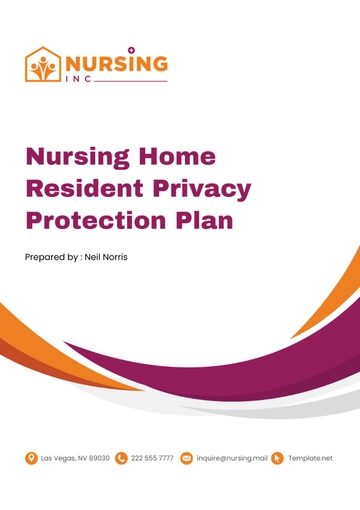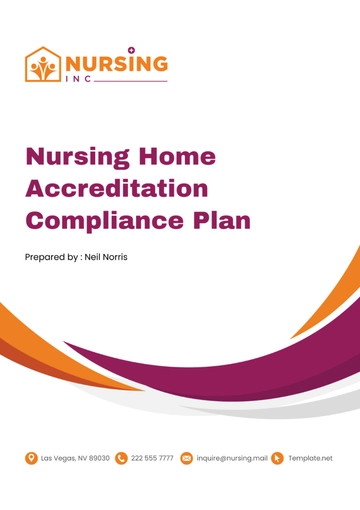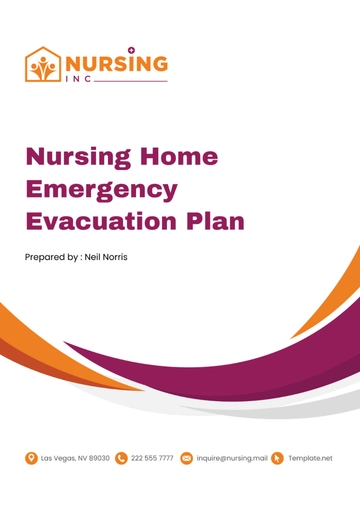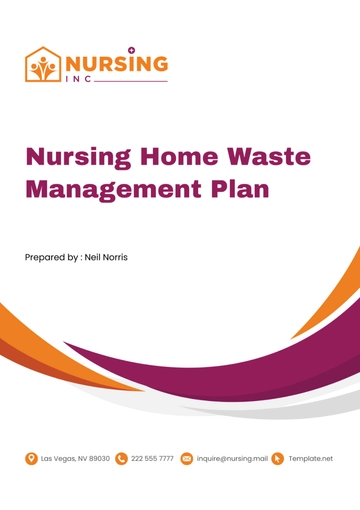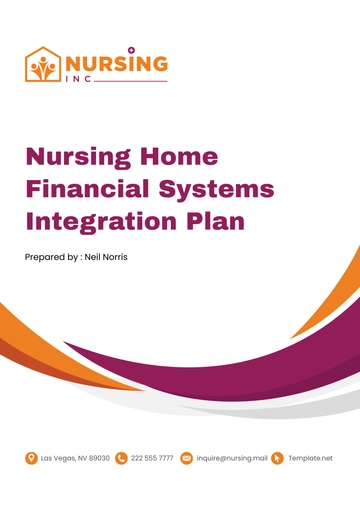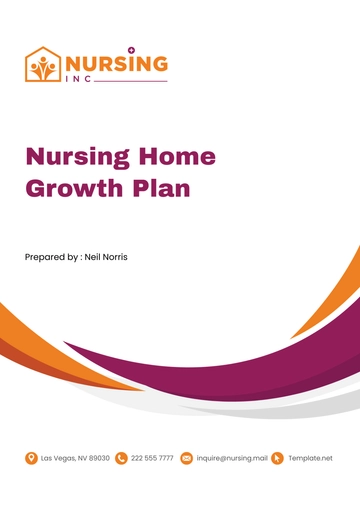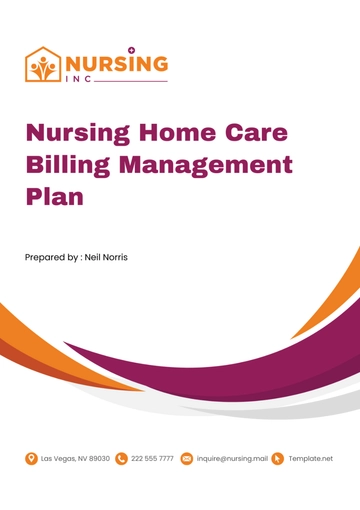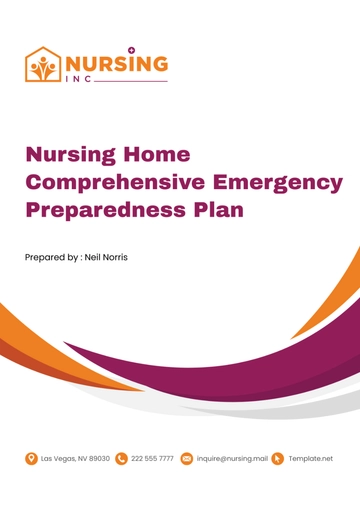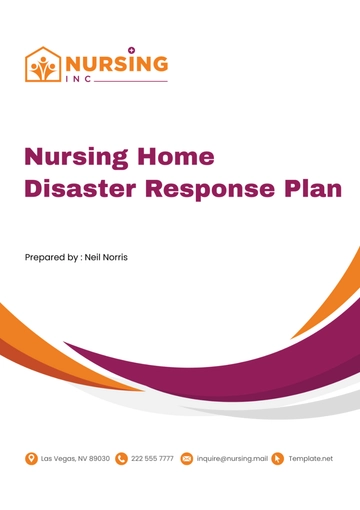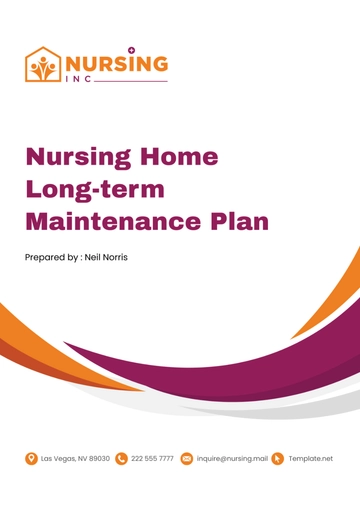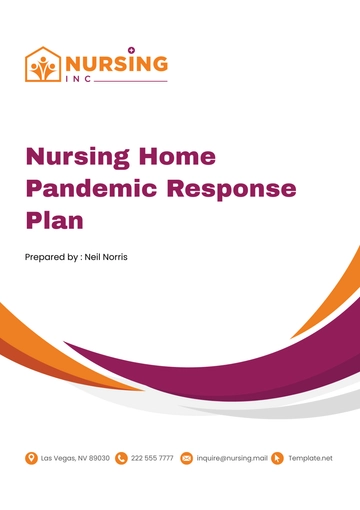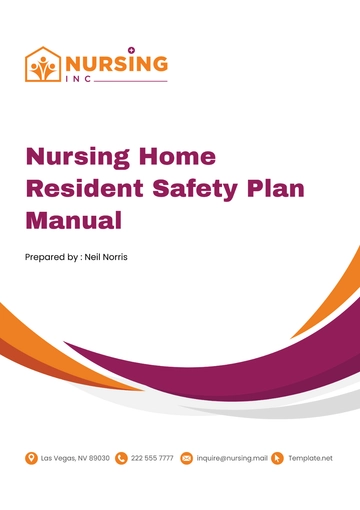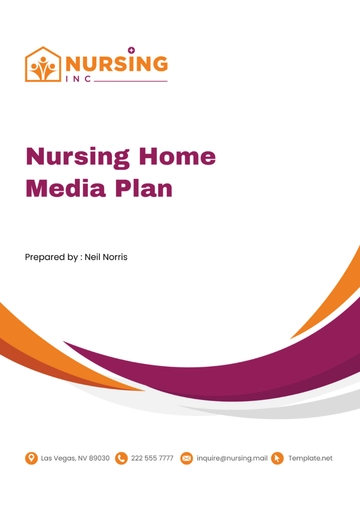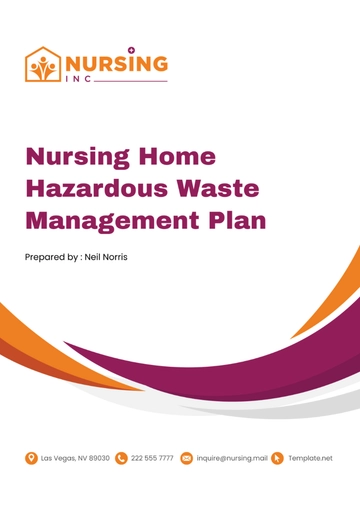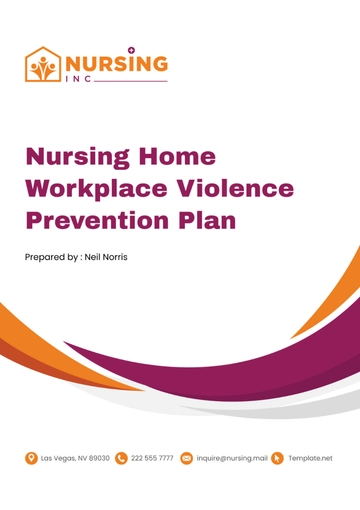Free Nursing Home Hazardous Waste Management Plan
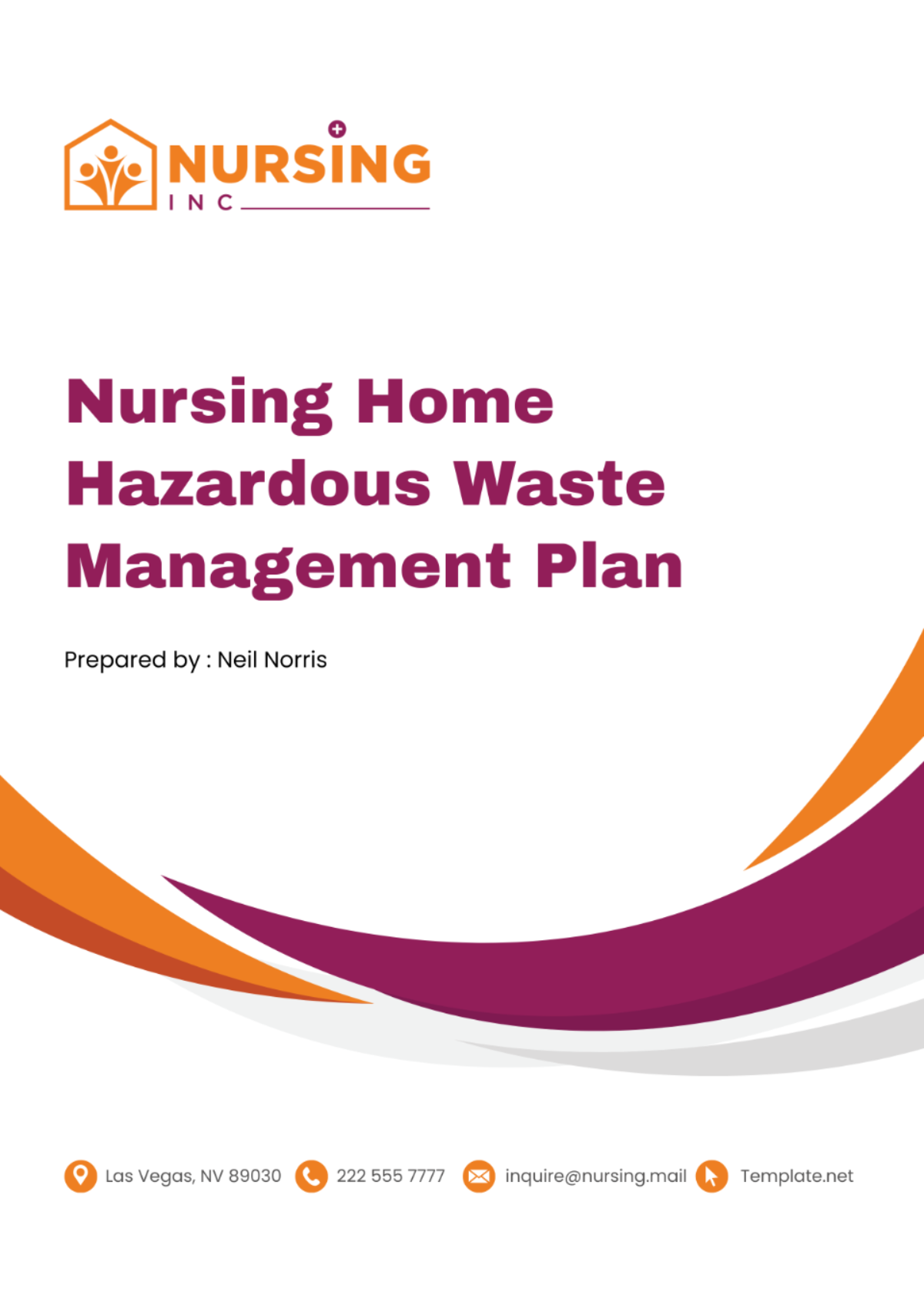
Introduction
This Hazardous Waste Management Plan (HWMP) is designed to ensure the safe and compliant management of hazardous waste at [Your Company Name]. It aims to protect the health and safety of our residents, staff, and the environment by outlining procedures for the proper handling, storage, and disposal of hazardous materials.
Hazardous Waste Identification
Identifying hazardous waste is the first critical step in ensuring safe and compliant waste management. This section outlines the types of hazardous waste generated at [Your Company Name], classified according to federal and state regulations.
Types of Hazardous Waste:
Waste Type | Description | Hazard Class |
|---|---|---|
Pharmaceuticals | Expired or unused medications | Toxic, Ignitable |
Cleaning Chemicals | Disinfectants, solvents, etc. | Corrosive, Reactive, Toxic |
Electronic Waste | Batteries, electronics | Toxic, Reactive |
Sharps | Needles, lancets | Biohazard, Puncture Hazard |
Waste Accumulation and Storage
Effective accumulation and secure storage of hazardous waste are paramount for safeguarding the health and safety of our community, including residents, staff, and the environment. The protocols delineated herein aim to fortify [Your Company Name]'s commitment to maintaining stringent safety standards. These protocols are designed to mitigate risks associated with hazardous waste.
Segregation of Waste: Hazardous waste must be segregated by type and hazard class at the point of generation to prevent chemical reactions, reduce the risk of accidents, and facilitate more efficient disposal. Clear signage and color-coded bins will be used to aid in the segregation process.
Secure Containers and Labeling: All hazardous waste must be accumulated in containers that are compatible with the waste material, structurally sound, leak-proof, and securely sealed. Each container must be clearly labeled with the contents, hazard class, accumulation start date, and the words "Hazardous Waste."
Controlled Storage Areas: Designated storage areas for hazardous waste must be equipped with secondary containment systems, such as spill pallets or containment berms, to contain leaks or spills. These areas will be subject to strict access control, ensuring that only authorized personnel can enter.
Environmental Controls: Storage areas must be maintained under conditions that minimize the risk of waste degradation or container failure. This includes temperature control, ventilation, and protection from direct sunlight, as appropriate for the type of waste stored.
Regular Inspections: Storage areas will be inspected weekly for signs of leaks, container deterioration, or regulatory non-compliance. These inspections will be documented, and any identified issues will be addressed promptly to ensure continuous safety and compliance.
Maximum Storage Time Limits: To minimize the volume of hazardous waste stored on-site and to ensure timely disposal, [Your Company Name] Nursing Home will adhere to regulatory time limits for the accumulation of hazardous waste. The facility will implement internal procedures to track the accumulation start dates and ensure waste is disposed of within the allowed time frames.
Employee Training: All staff members involved in the handling, storage, or disposal of hazardous waste will receive comprehensive training on these enhanced procedures. This training will cover waste identification, proper use of containers and labeling, storage area maintenance, and emergency response protocols. Training will be conducted annually and upon the introduction of new waste types or changes in regulatory requirements.
Through the implementation of these enhanced procedures for waste accumulation and storage, [Your Company Name] reaffirms its dedication to upholding the highest standards of safety, regulatory compliance, and environmental stewardship.
Waste Disposal Procedures
The disposal of hazardous waste is a critical component of [Your Company Name]'s commitment to environmental stewardship, public health, and regulatory compliance. Given the complexities and risks associated with hazardous waste, it is imperative that disposal practices are meticulously planned and executed. This section elaborates on the sophisticated procedures designed to ensure the safe, efficient, and compliant disposal of hazardous materials generated within our facility.
Selection of Licensed Contractors: [Your Company Name] will engage only licensed and reputable hazardous waste disposal contractors. These contractors must demonstrate compliance with all relevant local, state, and federal regulations, and possess a proven track record of environmentally responsible disposal practices.
Verification of Disposal Methods: Prior to disposal, the chosen disposal method for each type of hazardous waste will be verified for compliance with regulatory standards and environmental sustainability. This includes confirming the appropriateness of methods such as incineration, recycling, chemical neutralization, and autoclaving, depending on the waste type.
Documentation and Tracking: For every disposal action, comprehensive documentation will be maintained, including the type and quantity of waste, the disposal method, and the contractor used. This documentation will serve not only as a record of compliance but also as a tool for auditing and continuous improvement.
Pharmaceutical Waste Disposal: Special attention will be given to the disposal of pharmaceutical waste, utilizing methods such as incineration at facilities equipped to handle the unique hazards of these materials. This ensures the prevention of contamination to water systems and soil.
Sharps and Biohazardous Waste: Sharps and other biohazardous wastes will be autoclaved or incinerated by medical waste contractors to neutralize potential infectious hazards effectively before disposal, adhering to stringent health and safety standards.
Electronic Waste Management: Electronic waste, including batteries and electronic equipment, will be directed to certified e-waste recycling facilities to recover valuable materials and prevent harmful environmental impacts associated with landfill disposal.
Continuous Evaluation of Disposal Impact: The environmental and health impacts of waste disposal methods will be continuously evaluated. [Your Company Name] Nursing Home commits to adopting newer, more sustainable disposal technologies as they become available, striving for minimal environmental impact.
Employee and Contractor Training: Employees involved in the waste disposal process, along with contracted disposal personnel, will receive ongoing training in safe handling practices, emergency response, and regulatory compliance to ensure the highest levels of safety and environmental protection.
Regulatory Compliance and Auditing: Regular audits will be conducted to verify adherence to all applicable waste disposal regulations and to identify opportunities for process improvement. These audits will help ensure that disposal practices remain compliant and are aligned with best practices for environmental protection.
Through the implementation of these advanced waste disposal procedures, we aim to achieve a balance between operational efficiency, regulatory compliance, and our overarching commitment to environmental conservation and public health.
Training and Emergency Response
Ensuring that all staff members are adequately trained in hazardous waste management and emergency response is crucial for the safety of our facility. This section outlines the training requirements and emergency response procedures.
Training and Emergency Response Overview:
Topic | Description | Frequency |
|---|---|---|
Hazardous Waste Handling | Procedures for safe handling and disposal of hazardous waste | Annually |
Emergency Response | Procedures for responding to hazardous waste spills or exposures | Annually |
Regulatory Compliance | Overview of relevant local, state, and federal regulations | Bi-annually |
Record Keeping and Reporting
Maintaining accurate records and reporting is essential for compliance with regulatory requirements and for tracking the effectiveness of the hazardous waste management program. This section details the record-keeping and reporting responsibilities of [Your Company Name].
Record Keeping and Reporting Requirements:
Document | Description | Retention Period |
|---|---|---|
Waste Disposal Records | Records of all hazardous waste disposals, including contractor details and disposal methods | 5 years |
Training Records | Records of staff training on hazardous waste management and emergency response | 3 years |
Incident Reports | Documentation of any incidents or spills involving hazardous waste | 5 years |
Waste Minimization and Pollution Prevention
Waste minimization and pollution prevention are critical components of an effective hazardous waste management plan. By reducing the volume and toxicity of waste generated, [Your Company Name] Nursing Home aims to lessen the environmental impact and improve operational efficiency.
Inventory Management: Regular inventory checks to ensure that only necessary quantities of chemicals and pharmaceuticals are ordered, minimizing excess and waste.
Substitution of Less Hazardous Materials: Whenever possible, substituting less hazardous or non-hazardous materials for those that are considered hazardous.
Employee Training: Continuous education and training for employees on waste reduction techniques and the importance of pollution prevention.
Recycling Programs: Implementing recycling programs for non-hazardous materials such as paper, plastic, and metal to reduce the overall volume of waste.
Energy Efficiency: Adopting energy-efficient practices and equipment to reduce environmental impact and promote sustainability within the facility.
Compliance Auditing and Program Review
Regular audits and reviews of the Hazardous Waste Management Plan are essential to ensure ongoing compliance with regulatory requirements and the effectiveness of the waste management practices. We commit to periodic evaluations to identify areas for improvement and to adapt to new regulations or operational changes.
Annual Compliance Audits: Conducting comprehensive audits annually to evaluate adherence to the HWMP, regulatory compliance, and the effectiveness of implemented procedures.
Program Review Meetings: Holding semi-annual program review meetings with key staff members to discuss the outcomes of audits, incident reports, and any regulatory updates that may impact the HWMP.
Corrective Action Plans: Developing and implementing corrective action plans in response to audit findings to address and rectify identified issues.
Regulatory Update Reviews: Regularly reviewing changes in local, state, and federal regulations to ensure the HWMP remains compliant and up to date.
Stakeholder Feedback: Encouraging feedback from employees, residents, and regulatory bodies to continually improve the HWMP and foster a culture of safety and environmental responsibility.
Conclusion
This Hazardous Waste Management Plan is a living document, subject to review and revision to reflect changes in regulations, facility operations, or waste management practices. [Your Company Name] is committed to the continuous improvement of our hazardous waste management program to ensure the safety of our community and the protection of the environment.
- 100% Customizable, free editor
- Access 1 Million+ Templates, photo’s & graphics
- Download or share as a template
- Click and replace photos, graphics, text, backgrounds
- Resize, crop, AI write & more
- Access advanced editor
Template.net presents the Nursing Home Hazardous Waste Management Plan Template, a crucial tool for ensuring environmental safety and compliance. This editable template allows for planning and customization, ensuring your hazardous waste management strategies are thoroughly communicated. Edit seamlessly in our Ai Editor Tool, elevating your waste management protocols to new standards.
You may also like
- Finance Plan
- Construction Plan
- Sales Plan
- Development Plan
- Career Plan
- Budget Plan
- HR Plan
- Education Plan
- Transition Plan
- Work Plan
- Training Plan
- Communication Plan
- Operation Plan
- Health And Safety Plan
- Strategy Plan
- Professional Development Plan
- Advertising Plan
- Risk Management Plan
- Restaurant Plan
- School Plan
- Nursing Home Patient Care Plan
- Nursing Care Plan
- Plan Event
- Startup Plan
- Social Media Plan
- Staffing Plan
- Annual Plan
- Content Plan
- Payment Plan
- Implementation Plan
- Hotel Plan
- Workout Plan
- Accounting Plan
- Campaign Plan
- Essay Plan
- 30 60 90 Day Plan
- Research Plan
- Recruitment Plan
- 90 Day Plan
- Quarterly Plan
- Emergency Plan
- 5 Year Plan
- Gym Plan
- Personal Plan
- IT and Software Plan
- Treatment Plan
- Real Estate Plan
- Law Firm Plan
- Healthcare Plan
- Improvement Plan
- Media Plan
- 5 Year Business Plan
- Learning Plan
- Marketing Campaign Plan
- Travel Agency Plan
- Cleaning Services Plan
- Interior Design Plan
- Performance Plan
- PR Plan
- Birth Plan
- Life Plan
- SEO Plan
- Disaster Recovery Plan
- Continuity Plan
- Launch Plan
- Legal Plan
- Behavior Plan
- Performance Improvement Plan
- Salon Plan
- Security Plan
- Security Management Plan
- Employee Development Plan
- Quality Plan
- Service Improvement Plan
- Growth Plan
- Incident Response Plan
- Basketball Plan
- Emergency Action Plan
- Product Launch Plan
- Spa Plan
- Employee Training Plan
- Data Analysis Plan
- Employee Action Plan
- Territory Plan
- Audit Plan
- Classroom Plan
- Activity Plan
- Parenting Plan
- Care Plan
- Project Execution Plan
- Exercise Plan
- Internship Plan
- Software Development Plan
- Continuous Improvement Plan
- Leave Plan
- 90 Day Sales Plan
- Advertising Agency Plan
- Employee Transition Plan
- Smart Action Plan
- Workplace Safety Plan
- Behavior Change Plan
- Contingency Plan
- Continuity of Operations Plan
- Health Plan
- Quality Control Plan
- Self Plan
- Sports Development Plan
- Change Management Plan
- Ecommerce Plan
- Personal Financial Plan
- Process Improvement Plan
- 30-60-90 Day Sales Plan
- Crisis Management Plan
- Engagement Plan
- Execution Plan
- Pandemic Plan
- Quality Assurance Plan
- Service Continuity Plan
- Agile Project Plan
- Fundraising Plan
- Job Transition Plan
- Asset Maintenance Plan
- Maintenance Plan
- Software Test Plan
- Staff Training and Development Plan
- 3 Year Plan
- Brand Activation Plan
- Release Plan
- Resource Plan
- Risk Mitigation Plan
- Teacher Plan
- 30 60 90 Day Plan for New Manager
- Food Safety Plan
- Food Truck Plan
- Hiring Plan
- Quality Management Plan
- Wellness Plan
- Behavior Intervention Plan
- Bonus Plan
- Investment Plan
- Maternity Leave Plan
- Pandemic Response Plan
- Succession Planning
- Coaching Plan
- Configuration Management Plan
- Remote Work Plan
- Self Care Plan
- Teaching Plan
- 100-Day Plan
- HACCP Plan
- Student Plan
- Sustainability Plan
- 30 60 90 Day Plan for Interview
- Access Plan
- Site Specific Safety Plan
